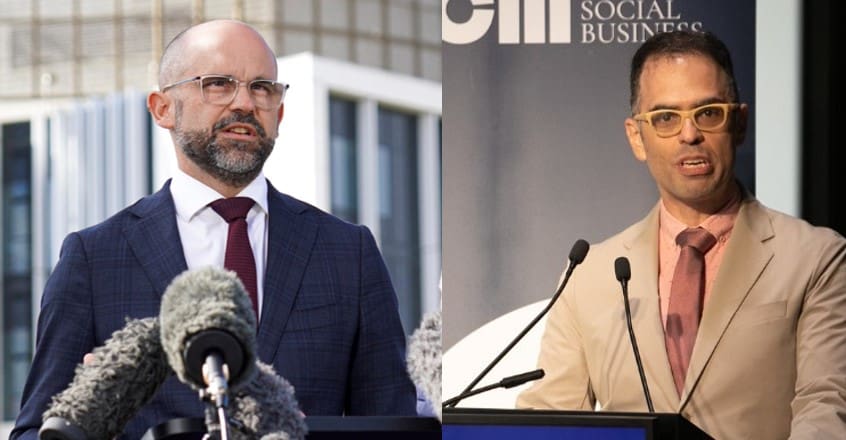
Qld Treasurer David Janetzki and NSW Treasurer Daniel Mookhey.
BOOSTING biosecurity was a central feature of the Queensland and New South Wales 2025-26 budgets released on Tuesday, with a combined $184.9 million in extra funding announced across the two states.
These measures come alongside extra funding for priority areas within each state’s agriculture department, including investments in upgrades at several research facilities.
A key part of Queensland’s biosecurity boost is a $60.9M, five-year package to fund 100 additional frontline officers at biosecurity hotspots, and roll out regionally targeted plans to control invasive species like feral pigs and varroa mite.
This is on top of $24M over four years to fund aerial suppression by the Fire Ant Suppression Taskforce, aimed at significantly reducing fire ant numbers.
The NSW Government released its biosecurity spend over a week before budget day, with $100M in new additional funding to further strengthen the state’s biosecurity detection, protection and response.
NSW Premier Chris Minns said the extra funding brings the state’s biosecurity budget to a historic $1.05 billion.
He said these funds will help drive the development of a new, sustainable and integrated biosecurity model, as well as enable strengthening of surveillance and improve the state’s emergency response capacity in the event of a biosecurity incursion.
“I’ve been lucky to meet with many farmers across our state and listen to their concerns; whether it’s feral pigs, deer, weeds or fire ants, all of them have raised the unrelenting threat biosecurity incursions pose,” Mr Minns said.
“That is why we are making this essential investment to ensure that farmers can continue to do what they do best, knowing that the government has their back when it comes to managing weeds and pests across the state.”
Qld Minister for Primary Industries Tony Perrett said the budget delivers better biosecurity and more invasive-species management to grow Qld’s primary industries.
“For the first time in a decade, Queensland’s primary industries are being delivered a budget that focuses on what they need to enable them to produce world-class food, fibre and foliage for Queenslanders and the world,” Mr Perrett said.
“We are backing primary industries by beefing up biosecurity by delivering the first of 100 additional officers across the regions with a focus on biosecurity hotspots.”
Ag project spend
Both budgets also feature new funding for initiatives to support primary producers and bolster agricultural research and development.
Key Qld Government projects include:
- $3.4M to finalise the Master Plan and AgTech Infrastructure Development at the Emerald Smart Cropping Centre in Central Qld;
- $1.8M to construct a glasshouse at the Gatton Research Facility in the Lockyer Valley;
- $1.7M to upgrade the Wild Dog Barrier Fence in south-west Qld; and,
- $784,000 for major upgrades to site infrastructure including water mains and air-handling systems across multiple research facilities including Tick Fever Centre at Wacol in Brisbane, and the Gatton Research Facility.
The state has also allocated $4.5M over two years for a bigger and better Beef 2027 event in Rockhampton.
There is also more funding under innovation funds and grant programs, such as, $51.9M over four years to support the Farm Business Resilience Program, Regional Drought Resilience Planning Program and Drought Preparedness Grants and $30M for a new Sowing the Seeds of Farming Innovation Fund.
The NSW Budget features $41.2M to modernise the primary industry research and development program.
This includes $6.25M for a new research station upgrade program – part of a four-year project totalling $12.5M – along with extra funding for ongoing projects such as $20.47M for research services infrastructure, $4.622M for the Orange Agricultural Institute upgrade, and $2M for the R&D partnership with the Grains Research and Development Corporation.
NSW Farmers calls for more funding
While welcoming the additional funding, NSW Farmers has said more was needed to secure a brighter future for the farming sector.
NSW Farmers president Xavier Martin said while farmers acknowledged the funding and the state’s boost to biosecurity and agricultural innovation, more was still needed to secure a brighter future for farmers.
“Funding to fight pests and bolster our biosecurity is all welcome news – but we’re still waiting on the detail as to where this money is really going, and one-off payments won’t do the job,” Mr Martin said.
Initiatives to boost the sustainability of NSW’s agricultural workforce additionally remained long overdue, Mr Martin said, with the state’s peak farm body calling on the Minns Government to step up on upskilling future farm communities.
“Young people are the future of our state, and we must invest in building their skills, providing the services and creating the opportunities that foster a bright future for those in our regions.”
NSW DPIRD operating loss
The NSW budget documents also provided a breakdown of the Department of Primary Industries and Regional Development’s (DPIRD) balance sheet.
The budget papers show the department is expected to post an operating loss of $10.44M for 2025-26, a sharp turnaround from the revised $244.39M profit forecast for 2024-25.
Total DPIRD expenses are estimated at $2.051B for 2025-26, up 17 percent on the revised 2024-25 figure, but lower than the original 2024-25 budget estimate of $2.43B.
The shift is largely due to changes in employee-related expenses – projected at $601.24M for 2025-26, up from the revised $565.17M for 2024-25 but below the original $622.57M budget – and a drop in “other operating expenses”, which are expected to fall to $457.37M in 2025-26, compared with $480.11M revised and $869.8M originally budgeted for 2024-25.
Departmental revenue is forecast at $2.04B for 2025-26, up from the 2024-25 revised total of just over $2B but down from the budgeted figure of $2.53B.
The “grants and contributions” revenue for 2025-26 is estimated at $529.9M, up from the revised 2024-25 figure of $408M, but significantly lower than the 2024-25 budgeted amount of $864.55M.
The NSW budget papers note that each department’s accounting result reflects the net cost of services, adjusted for government contributions, but does not equate to the overall budget result or the Government Finance Statistics cash surplus or deficit.
Grain Central: Get our free news straight to your inbox – Click here

HAVE YOUR SAY